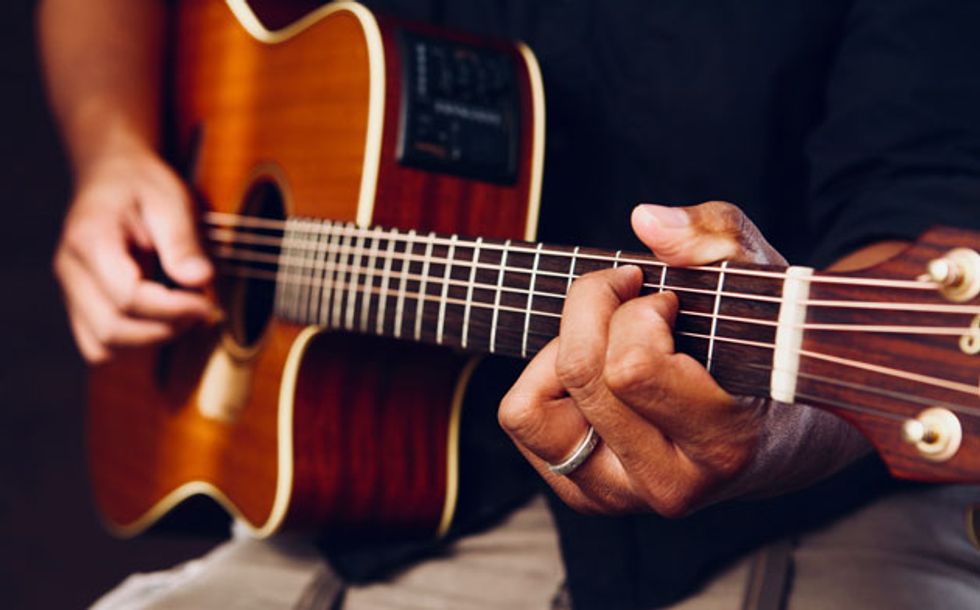Theory: Intermediate
Lesson Overview:
• Understand the basics of the Bentonia style.
• Learn about “Skip” James, Jimmy “Duck” Holmes, and Jack Owens.
• Develop fluency in open Dm tuning. Click here to download a printable PDF of this lesson's notation.
Bentonia, Mississippi, has quietly produced one of the most unique and hauntingly expressive sounds in the Delta blues canon. Although this small rural town currently has only about 800 residents, it has influenced music all over the world through the dramatic minor tonality, ethereal chord voicings, and syncopated guitar motifs that are signatures of the region. Guitarist Henry Stuckey is said to be the originator of the tradition, but historically the most well-known proponent of the Bentonia sound may be Nehemiah “Skip” James, who produced some of the finest pre-war blues recordings for Paramount Records in 1931—long before Cream had a hit record with the James composition “I’m So Glad” in 1966.
Skip James died in 1969 and the legacy of Bentonia blues was carried on by Jack Owens, who later passed the torch to Jimmy “Duck” Holmes, a deep blues guitarist and singer who remains active today as both a musician and as the owner of the Blue Front Cafe, which is the world’s oldest juke joint. While there is much more that can be said about the origin of the tradition and its evolution over the years, this lesson will focus on introducing essential elements of the Bentonia sound, including the tuning famously associated with the style, some common chord shapes, basic turnarounds and two characteristic licks that will get you familiar with the vibe. For more about Jimmy “Duck” Holmes and the music of Bentonia, check out “Ouija Board Blues: Jimmy ‘Duck’ Holmes.”
A good way to discover the core qualities of the Bentonia sound is by listening to the region’s most celebrated song, “Devil Got My Woman.” This tune has been performed by every recorded artist from the region, including James, Owens, and Holmes, as well as Cornelius Bright and Jacob Stuckey. For a clearer sense of the tradition and its underlying characteristics, I recommend hearing the song in its various incarnations by each of these artists, all of which are available on YouTube.
With its haunting poetic images and pensive tone, “Devil” primarily revolves around the Im and Vm chords, connected by a recurring lick that is at the heart of the style. For the following examples, we take inspiration from Skip James and Jimmy “Duck” Holmes, who offer two highly individual interpretations of the Bentonia anthem in the following videos. As you’ll see, James performs “Devil Got My Woman” before an intimate audience of peers (including Howlin’ Wolf and Son House) behind the scenes at the 1966 Newport Folk Festival, and Holmes brings the song into the present day with “I’d Rather Be the Devil” onstage in Europe at the 2013 Rootsway Festival.
Tuning, Scales, and Shapes
In these videos, James is tuned to open Em, while Holmes plays in open Ebm. However, on record both musicians can often be found in open Dm (D–A–D–F–A–D), which is what we will use for our examples. James referred to this as the “crossnote” tuning for its ability to cross major and minor tonalities. Most of the music from Bentonia is played in crossnote, with the first finger generally fretting the 3rd string at the 1st fret to form a major chord. A variation of the minor tonic is also played between the 7th and 9th frets and the minor V7 is played as an open chord. Melodic improvisations come from the Dorian mode (1–2–b3–4–5–6–b7).
Essential Licks
Ex. 1 contains a variation of the Bentonia “signature lick,” in which alternating bass notes on the 6th and 4th strings anchor a melody on the 3rd string as it crosses from minor to major.
Click here for Ex. 1
In Ex. 2, the minor tonic moves up the neck and is embellished with the major 6th (B) in the Dorian mode.
Click here for Ex. 2
Intros and Turnarounds
Although turnarounds are not traditionally a feature of Bentonia’s hypnotic sound, Skip James used them in his later years. Ex. 3 and Ex. 4 are in the style of Skip’s video above.
Click here for Ex. 3
Click here for Ex. 4
Ex. 5 is an original turnaround inspired by Skip’s 1931 recording of “Devil Got My Woman.”
Click here for Ex. 5
The Minor V Chord
Minor and major IV chords aren’t typically used in the Bentonia style. Many songs in the canon use only the tonic. In some instances, such as “Devil Got My Woman,” a V7 chord appears. Ex. 6 shows how it is often played, using a little bit of bend on the b3 at the top of the chord.
Click here for Ex. 6
Put It All Together
True to the country blues aesthetic, the Bentonia style does not strictly follow an 8-, 12- or 16-bar form. The guitar follows the vocal and is an expression of how the artist interprets the music. However, Ex. 7 incorporates all of the above elements into a form that evokes the essence of “Devil Got My Woman.”
Click here for Ex. 7
Bentonia plays a crucial role in Mississippi blues history and continues to be a vital part of the state’s musical identity. If you are truly interested in Delta blues, one of the best things you can do is to make the trip down to hear the music firsthand. Go visit the Blue Front Cafe and you might be lucky enough to hear Jimmy “Duck” Holmes perform and personally explain what the style is all about. In the meantime, listen closely to the masters and practice slowly. You’ll begin to get a feel for one of the deepest traditions in the blues.











![Rig Rundown: Russian Circles’ Mike Sullivan [2025]](https://www.premierguitar.com/media-library/youtube.jpg?id=62303631&width=1245&height=700&quality=70&coordinates=0%2C0%2C0%2C0)










